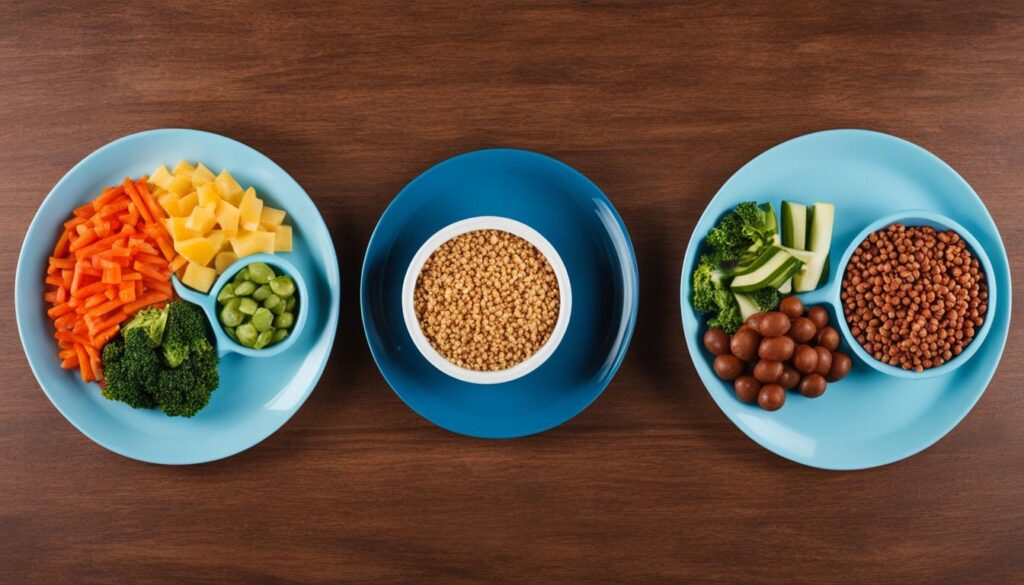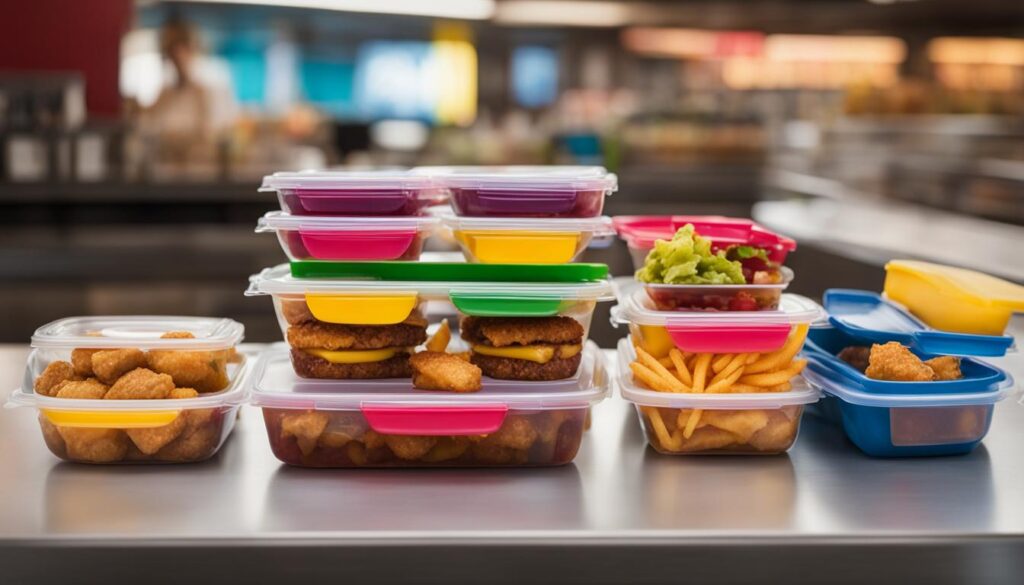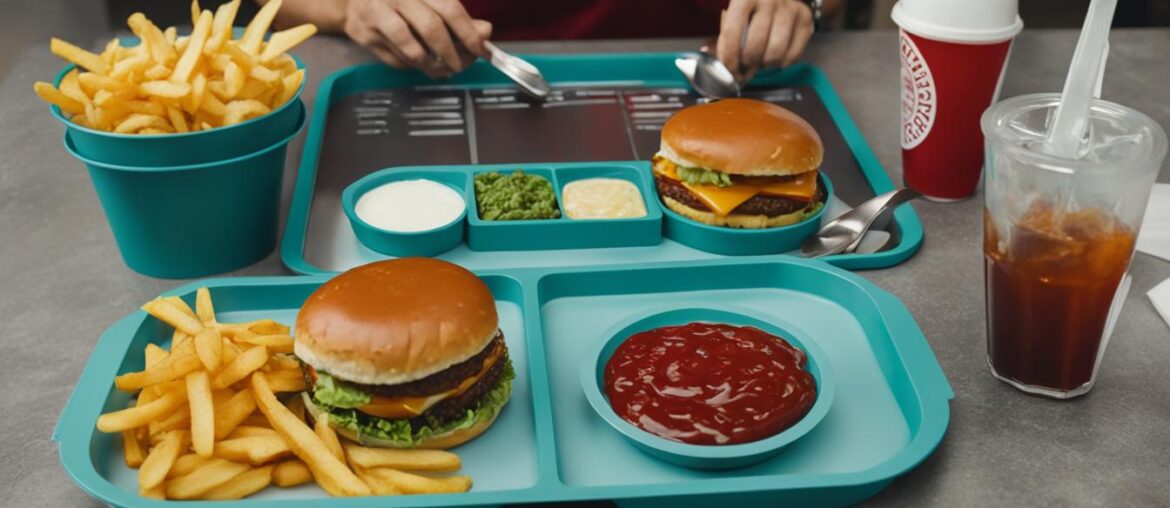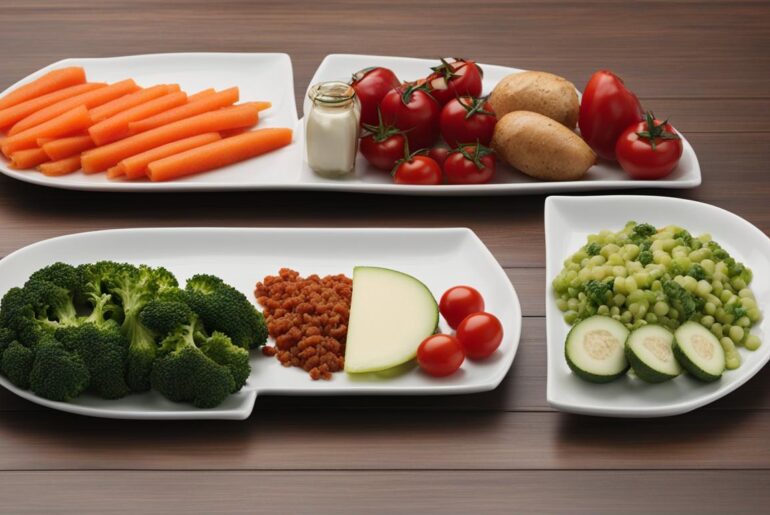When it comes to fast food meals, portion control is often overlooked. However, it plays a crucial role in maintaining a healthy diet and managing calorie intake. With the increasing portion sizes of ultraprocessed foods, practicing portion control is more important than ever before.
Research has shown that consuming large portions on a regular basis can lead to overeating and contribute to obesity and related health conditions. Ultraprocessed foods, which are often served in sizes up to five times larger than before, can easily derail our efforts to maintain a healthy weight.
But what exactly is portion control? It involves being mindful of the amount of food we consume and making conscious choices to ensure we’re eating healthy portion sizes. By practicing portion control, we can enjoy our favorite fast food meals without compromising our health.
Key Takeaways:
- Portion control is essential for managing calorie intake and maintaining a healthy weight.
- Large portion sizes in fast food meals can contribute to overeating and obesity.
- Practicing portion control involves being mindful of the amount of food we consume and making conscious choices.
- Ultraprocessed foods are often served in sizes up to five times larger than before.
- By mastering portion control, we can enjoy our favorite fast food meals while promoting better health (check this post out).
The Impact of Large Portion Sizes
Research has shown that consuming very large portions on a regular basis can have a significant impact on our health. Not only can it contribute to obesity, but it can also increase the risk of developing serious health conditions such as heart disease and Type 2 diabetes. Additionally, overeating can lead to other health issues like sleep apnea, osteoarthritis, and gallbladder disease.
One of the main factors contributing to large portion sizes is the availability of supersized meals in fast food restaurants. These meals often contain an excessive amount of calories, unhealthy fats, and added sugars, making them a major contributor to weight gain. Furthermore, the increased consumption of ultraprocessed foods, which are typically offered in larger sizes, further exacerbates the problem of overeating and calorie control.
It is crucial to understand the impact that large portion sizes can have on our health and take measures to control our calorie intake through portion control techniques (check this post out). By practicing portion control, we can effectively manage our calorie consumption and make healthier choices that support our overall well-being.
| Health Consequences of Large Portion Sizes | Fast Food Consumption | Ultraprocessed Foods |
|---|---|---|
| 1. Increased risk of obesity | 1. Availability of supersized meals | 1. Offered in larger sizes |
| 2. Higher risk of heart disease | 2. Excessive calories, unhealthy fats, and added sugars | 2. High calorie content and unhealthy additives |
| 3. Greater risk of Type 2 diabetes | 3. Contributing factor to weight gain | 3. Lack of nutritional value |
| 4. Increased likelihood of sleep apnea | 4. Negative impact on sleep quality | |
| 5. Higher risk of osteoarthritis | 5. Excess weight and inflammation | |
| 6. Greater probability of gallbladder disease | 6. High fat content |
Controlling calories in fast food and managing portion sizes is essential for maintaining a healthy lifestyle (check this post out). By being mindful of our portion sizes and making conscious choices about what we eat, we can avoid the negative consequences associated with overeating. The next section will provide valuable tips and techniques for practicing portion control and making healthier choices when dining out.
Tips for Practicing Portion Control
When it comes to maintaining portion control while enjoying fast food meals, implementing effective strategies is key. By following these tips, you can better manage your calorie intake and promote mindful eating:
- Limit portions of ultraprocessed foods: These foods are often sold in larger sizes, so be mindful and opt for smaller servings.
- Choose smaller sizes for chocolate: Limit yourself to a small number of squares per day or opt for individually wrapped mini chocolates.
- Opt for the smallest menu offering for french fries: This helps control portion sizes or consider sharing an order with a friend.
- Choose the smallest size of soda: When dining out, opt for the smallest size of soda or use a smaller glass at home to limit the amount consumed.
- Use a measuring cup for portioning cereal: Instead of eating directly from the cereal box, use a measuring cup to portion out an appropriate amount.
- Make hamburgers your meat for the day: When incorporating meat into your meal, choose a hamburger patty and try to include plant-based options as well.
- Choose single-serving packages for potato chips: When indulging in potato chips, opt for single-serving packages or use a measuring cup for larger bags.
By implementing these portion control techniques, you can effectively manage your calorie intake and promote healthier eating habits.
Choosing the Right Portion Sizes

When it comes to maintaining a healthy diet and managing calorie intake, choosing the right portion sizes is crucial. By selecting appropriate portions, you can ensure that you are meeting your nutritional needs without overeating. Here are some tips to help you make informed decisions about portion sizes:
- Incorporate more fiber-rich foods: Fill your plate with fruits and vegetables that are high in fiber. Not only do they provide essential nutrients, but they also increase satiety, helping you feel fuller for longer.
- Opt for healthier sides: When eating out, consider ordering half portions for pasta dishes or choosing salads or vegetable bowls as your side. This allows you to enjoy your favorite meals while keeping portion sizes in check.
- Beware of misleading packaging: It’s important to avoid assuming that a single bottle or bag contains a single serving. Always check the label for the number of servings per container to ensure you are consuming the appropriate portion size.
- Understand portion equivalents: Visualizing proper portion sizes can be challenging. However, by using common objects as reference points, you can get a better idea of what constitutes a serving. For example:
| Food | Portion Size Equivalent |
|---|---|
| Fruits or vegetables | A baseball-sized portion |
| Meat or fish | A deck of cards-sized portion (about 3 ounces) |
By understanding portion equivalents, you can make more mindful choices when serving yourself or ordering food.
Choosing the right portion sizes is essential for maintaining a healthy weight and promoting overall well-being. It allows you to enjoy a variety of foods while still managing your calorie intake. By incorporating these tips into your daily routine, you can practice portion control and make more informed choices about what you eat.
Practical Tips for Portion Control
When it comes to practicing portion control, there are several practical tips that can help you manage your calorie intake and make healthier choices, even when eating fast food. These tips can be incorporated into your everyday life and contribute to better eating habits. Let’s explore some of them:
- Use a smaller plate: Opt for a smaller plate when serving your meal. This can prevent overloading and make appropriate portions look more satisfying.
- Be selective with your sides: Avoid doubling up on carbohydrates by being mindful of your side choices. Choose healthier options like salads or vegetables instead of high-carb sides.
- Gauge portion sizes: Consider using measuring cups or your hand as a simple visual guide to estimate proper portion sizes (see my post here). This can help you avoid overeating and maintain a balanced diet.
- Drink water before meals: Drinking water before a meal can help you feel fuller and reduce the likelihood of overeating. Staying hydrated is also essential for overall health.
- Eat slower and be mindful: Take your time to chew your food thoroughly and savor each bite. Being more mindful during meals can help you recognize when you’re full and prevent overeating.
- Utilize pre-portioned meals: For those with busy lifestyles, pre-portioned meals can be a convenient way to practice portion control. These meals are already portioned out and can save you time while still allowing you to make healthier choices.
By following these practical tips, you can maintain healthy portion sizes and promote better eating habits. Embracing portion control is a valuable tool in controlling calorie intake, managing weight, and improving overall well-being.
Practical Tips for Portion Control – Summary:
| Tips | Description |
|---|---|
| Use a smaller plate | Opt for a smaller plate when serving your meal to prevent overloading. |
| Be selective with your sides | Choose healthier options for sides to avoid doubling up on carbohydrates. |
| Gauge portion sizes | Use measuring cups or your hand as a visual guide to estimate proper portion sizes. |
| Drink water before meals | Stay hydrated and reduce the likelihood of overeating by drinking water before meals. |
| Eat slower and be mindful | Savor each bite, chew thoroughly, and be mindful of your body’s signals of fullness. |
| Utilize pre-portioned meals | Pre-portioned meals can save time and still allow you to make healthy choices. |
Portion Control and Restaurant Dining
When dining out at restaurants, it’s important to be mindful of portion sizes and make conscious choices. Many restaurants serve oversized portions, which can contribute to overeating. Using smaller plates can help control portion sizes and prevent overeating. Avoiding finishing off others’ leftovers or nibbling on them can also help regulate portion control.
- The 20-minute rule: Wait for some time before reaching for a second helping, as it takes a while for the feeling of fullness to kick in.
- Checking food labels: Be aware of portion sizes indicated on packaging to make informed choices.
- Saying no to supersized options: Opt for regular-sized meals instead of larger portions.
- Considering additions: Assess whether certain extras, like bread or chips, are necessary with a meal to promote better portion control.
By being mindful of portion control while dining out, we can manage our calorie intake and make healthier choices. The key is to make conscious decisions and know when to stop.
Portion Control Made Easy with Meal Prep

Meal prepping is a valuable strategy for practicing portion control and managing calorie intake, especially when it comes to fast food meals. By buying pre-portioned meals that are already cooked and properly portioned, individuals can save time and still learn portion control practices. This is particularly beneficial for those with busy schedules who find it challenging to consistently monitor their portions.
Pre-portioned meals offer a convenient option for individuals looking to control their calorie intake and make portion control effortless. With the help of meal prep services, individuals can simplify the process of portion control and maintain a healthier lifestyle. By investing time in meal prepping, individuals can ensure they have access to nutritious meals that are appropriately portioned, making it easier to stick to their health goals.
Not only does meal prepping facilitate portion control, but it also allows for better overall meal planning and preparation. This method allows individuals to have full control over the ingredients and nutrients in their meals, ensuring they meet their specific dietary needs. By preparing meals in advance, individuals can eliminate the need for last-minute fast food choices and instead rely on pre-prepared, portion-controlled meals that align with their health goals.
Take advantage of meal prep services and discover how easy it is to implement portion control strategies and control calories in fast food meals (see my post here). By pre-portioning your meals, you can save time, simplify your eating routine, and maintain a balanced diet.
| Benefits of Meal Prep for Portion Control | How to Get Started with Meal Prepping |
|---|---|
|
|
Conclusion
Practicing portion control is crucial for managing calorie intake, maintaining a healthy weight, and promoting overall well-being. The increasing portion sizes of fast food meals and ultraprocessed foods have contributed to overeating and the obesity crisis. By implementing portion control strategies, such as limiting portions of unhealthy foods, choosing the right portion sizes, and being mindful during meals, individuals can take control of their calorie intake and make healthier choices.
Utilizing practical tips, like using smaller plates and measuring cups or drinking water before meals, can further aid in portion control. These simple changes can make a significant difference in managing portion sizes and preventing overeating. Additionally, meal prepping can be a convenient option for those looking to simplify portion control and maintain a balanced diet. By preparing pre-portioned meals, individuals can effortlessly manage their calorie intake and make portion control a seamless part of their routine.
By mastering portion control, individuals can enhance their health and well-being while still enjoying their favorite fast food meals. It’s not about completely eliminating foods we love but rather finding a balance and being mindful of our portions. With the right knowledge and strategies, individuals can make portion control a lifelong habit, leading to improved health outcomes and a healthier relationship with food.




